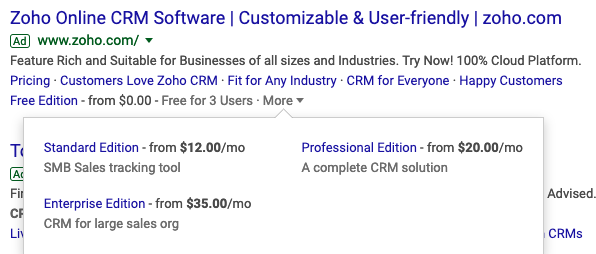On the surface, getting a higher click-through rate (CTR), more clicks, and more conversions may look great in a report. However, are those clicks and conversions from the right people?
Unqualified conversions don’t pay the bills.
Yes, you want to make sure you’re targeting the right audience and using the right keywords.
But, going one step further, carefully written ad copy can also help to gate out the people that aren’t relevant, limiting clicks to your true potential customers.
Read on to learn how to use PPC ads to prequalify traffic, discourage users you don’t want, and deliver better ROI.
1. Define a Qualified Conversion
Start by defining what a qualified conversion is for the business you’re advertising.
For ecommerce, that may mean any sale with a positive ROAS, a sale above a certain amount, or sales of specific priority products.
For a B2B company, that may mean a form submission from a person who’s the right fit for the service (for instance, a director-level job title and a company of 1,000+ people).
For a SaaS product, that may mean a contact who registers for a product demo.
Especially in the context of lead generation PPC, note that a qualified lead does not necessarily mean a closed deal. It simply references an individual who meets the criteria of your ideal target customer and has shown an interest in your product.
Depending on your business model, criteria for ideal leads may include factors like:
- Income.
- Age.
- Parental status.
- Geography.
- Home ownership.
B2B-specific criteria may include:
- Job titles.
- Company size.
- Industry.
2. Speak to Your Audience
Once you’ve identified the people who fit the proper criteria, think about how your ad messaging can speak directly to that audience.
Work with the marketing team and decision makers to identify personas and understand what content will appeal to those personas.
For instance, a college may be promoting adult education classes.
You don’t want to gear messaging toward teenagers and their parents, the approach taken by many undergraduate college ads. A dorm life preview day probably isn’t the best message to attract older students.
Instead, speaking toward adults looking to continue education might include messaging like “Looking for a New Career?”
With that phrase, you’re talking to people who have already entered the workforce, and are looking for a change.
Or you might mention benefits like night classes, which will especially appeal to those wanting to learn outside of a day job schedule.
Another example would be a home services company that wants to strictly reach homeowners.
Renters aren’t likely to make a decision about what HVAC company to call when their furnace goes down, but homeowners are the ones who will pay the bills.
In that case, use phrases like “Your Home Is Your Investment” will help to appeal more directly to those who own versus renters simply troubleshooting problems.
3. Use Qualifying Words
Think of words that set your brand apart from others who don’t fit the audience you want to reach. That way, if a user searches a term that’s relevant to your brand but isn’t actually a potential customer, the messaging can deter them from clicking.
Are you selling products targeted toward higher-income consumers and trying to discourage people looking for cheap deals? Use words like “luxury” and “high end.”
In the B2B space, qualifying words can set the tone for the types of businesses you want to attract. Are you targeting small businesses? Use words like “SMB” and “startup.”
Targeting larger businesses? Use words like “enterprise.” If you work with Fortune 500 companies, mention that in your copy.
In addition, if you’re bidding on keywords that could be searched by both B2C and B2B audiences, phrases like “for businesses” can help gate out consumers, when you only want business professionals to respond.
4. Mention Specific Numbers
Next, think of numbers that can set your business apart. Numbers can define anything from company size, to revenue, to age, depending on your target audience.
If your product targets companies of a certain size, mention size thresholds in your ad copy.
For instance, I work with a client who runs a website brokerage firm, helping web-based businesses sell their sites.
In order to combat submissions from people with unprofitable businesses, we explicitly mention a focus on “6-7 figure” sites. For instance, one ad description reads, “Partner with the website brokerage firm that sells more 6-7 figure ecommerce sites.”
In another instance, I ran a campaign for a retirement community. In order to make sure people in the proper age range were submitting inquiries, ads mentioned “55+ Community.”
5. Use Ad Extensions
Extensions provide an excellent opportunity to add detail and clarify brand messaging beyond the core ad copy.
Callout extensions can reinforce points previously touched on, like the size of companies you work with, as well as numbers (e.g., revenue amounts, age limits).
 Price Extensions Example
Price Extensions ExamplePrice extensions can give perspective on costs, to help people decide if your product or service is in their affordable range.
For instance, a SaaS company could list pricing for various software tiers. Users will know off the bat if they can afford the product if prices are easily visible.
Structured snippet extensions can highlight a “quick list” of the types of customers you work with.
For instance, you might provide software that’s used by financial institutions, so you can mention “types” of banks, credit unions, investment firms, etc.
This will help discourage people in irrelevant industries from clicking through. Or you can list out services, to focus on people looking for those items.
Start Testing!
As any PPC pro knows, ad copy testing is key to successful campaign performance.
While the application for every business will be different, think about copy that you can test to better narrow focus toward the right audience.
- Determine what people fit a qualified conversion category
- Think about what messaging will best appeal to those people versus generic messaging that might get clicked by those outside of your target audience.
- Identify qualifying words and numbers that help define who your business serves.
- Incorporate ad extensions for extra clarification.
Define your audience, start writing, and start testing!
More Resources:
- 10 Paid Search & PPC Best Practices for 2019
- How to Turn PPC Failure Into Success: 4 Lessons Learned
- PPC 101: A Complete Guide to Pay-Per-Click Marketing Basics
Image Credits
Featured Image: Pixabay.com
Screenshot taken by author, February 2019





